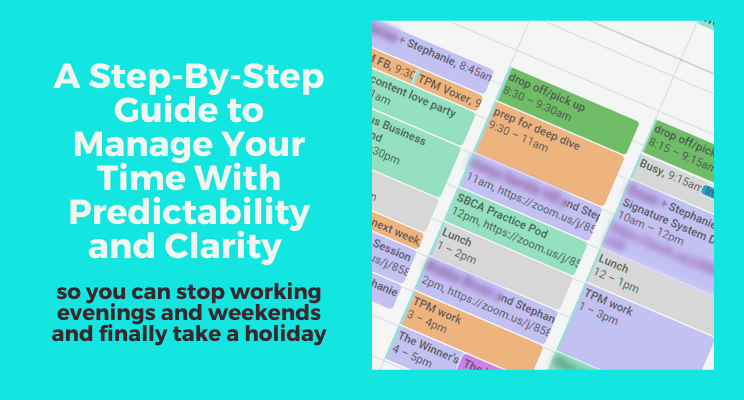
First, let’s get some things out of the way.
1. You can’t actually manage time, you can only manage your attention
2. No matter how efficient you are, you’ll never be able to magically fit too many things into one day
The theme in my coaching calls this month seems to be time blocking and using a calendar, so I thought it was time to share the methods to my madness.
Truth be told, I’ve always been pretty good at this stuff. I was the kid that actually used my agenda in school and loved to pick out a new pretty one each year. It was an adjustment when I worked for BlackBerry and needed to have my calendar digitized and synced to my phone, but that just opened up more possibilities for colour-coding and adding details. When I started my own business I went back to paper planners but quickly realized the benefits of going digital again (with a little arm-twisting from Patti Lustig in her former course on time management).
And still, my systems are ever-evolving. When something stops working, or something in life changes, I adjust my schedule. But that’s the key: you can’t adjust something you don’t have in the first place. Budgeting time works a lot like budgeting money, except that you can’t just make more!
This article, first and foremost, is about awareness. When you know what you’re doing when, you have clarity. You can sit down at your desk and know exactly what you need to do without wasting mental energy figuring it out in the moment. You know that what you’re working on is the best use of your time, and you know you’ll be working towards your goals instead of just reacting to what comes your way. You know if you can take on more work, you know if you can commit to a new course, and you know when you can take a holiday.
Unlike most articles where there’s always something more, today I’m going to try to share everything I know about time management because it can be quite simple if you let it be. The complexity comes in the “attention management” part where you have to decide what’s worth your attention in any given moment, and that’s a much longer conversation.
I should say that I don’t believe you should do this for every minute of every day. This is a powerful tool to use for work, but it can really take the joy and spontaneity out of daily life if you take it too far. I 100% recommend planning every hour of your workday, but use it outside of work time with caution.
Let’s start with the tools:
· Personally, I use Google Calendar on desktop and mobile because I have so many different Gmail calendars to sync and it works really well. You could use any digital calendar if you don’t have to merge things.
· For people to book into my calendar I use You Can Book Me. I set the available hours to be quite limited so I don’t get surprised by a client booking outside of my normal hours. There are dozens of great programs that can do this.
Most people have a digital calendar, and they may even have a booking system, but what I’ve found over and over again is that most people only put appointments with other people in their calendar. This is a good start, and we’re going to make it even more amazing.
Follow these steps to start populating your calendar:
1. Take some time to quietly reflect on what your ideal workday looks like. What does your ideal work week/month/year look like? What hours would you like to work? When are you at your best? What days do you want to work? When would you like to take breaks? Start your schedule from this place. You may not be able to work within this scope right away, but you might as well give it a try!
2. Now go to your calendar. Add in any non-negotiable commitments, standing meetings, lunch breaks, vacations, and time off. You might also add in drop-off and pick-up times for kids, school holidays, workouts, or whatever else you know about in advance. Use the “repeat” function in your calendar to make it easier.
3. If you’re using a booking calendar, make sure to set your start and end times in there. No need to set breaks since you’ll put those in your main calendar and they’ll be blocked off from there. If you feel like you might not stick to them, you can also put your start and end times in your main calendar, but they clutter things up too much for me.
Now you should start to see the time you have left to work with, and my guess is it’s less time than you thought. This is where it starts to get real and maybe a bit scary. You might start thinking already about extending your hours or shortening your breaks. For now, don’t. Leave them how they are.
4. Create your “time blocks”. These are chunks of time on your calendar for the things you know you have to do but aren’t necessarily meetings with other people. Things like content creation, finances, coursework, checking email/social, marketing, or any number of other things you have on your plate. I like to create all of these and put them on repeat in my calendar on a day I don’t work (so Fridays). They all pile up on top of each other all on the same day. Set them to repeat on the frequency you do them (daily, weekly, every other week, monthly, etc.) and set them to the length of time you think you need for each. You can colour-code them if you want at this point, and make sure they’re set as “busy” if you don’t want people potentially booking over them.
At this point your calendar might look something like this:

I used to have lots more regular time blocks, but I have since realized I don’t need them all so it’s down to the essentials. (Since I know you’re wondering…orange is my non-client work, purple is client work, dark green is anything I have to leave the house for, light green is my courses/masterminds, grey is blocked time off) Thursdays I try not to take client calls so I have an all day “busy” block called “work on business day”. Since I know I write every Monday morning, I moved that time block to the same time every week.
5. Do you have any time left for client work? No? If you still have too much on your plate, it’s time to get ruthless. There is no magic here. In the beginning you decided what you want your schedule to look like, right? Now you get to decide how badly you want that. You have a few options for “attention management” here, which I won’t go into detail about. You could reduce the amount of non-client work you do by potentially simplifying your business model or marketing strategy, you can hire someone to take things off your plate, you can raise your prices or update your offerings so you can make enough money with fewer clients, and there are other options as well. Probably what you’ll end up doing is a combination which might also include working more in the meantime while you figure out how to get closer to your ideal work schedule.
6. Finally, it’s time to fill in the white space. When your day starts, or even your week, you want to have your working hours all planned. I set aside time on Thursdays to plan my next week. That’s when I move all the Friday time blocks to other times throughout the week. (I wait because I like to give people a chance to book in my calendar then I fill the time around them, since they’re the priority). If my week gets filled with clients, then I know I have my Thursday to get the rest of the work done.
Some tips for filling in the white space:
· If you have the kind of business where you’re working on projects outside of calls with clients, then you need to schedule that in your calendar. That’s the only way you’ll know if you have the capacity to take on more work or not. When that client signs on with you, schedule in the time you’ll work on their project right away. If you have meetings where you know you’ll have follow-up work from, schedule that time in your calendar, too. This is the work that most commonly gets shoved to weekends or evenings because it absolutely must get done but it doesn’t get scheduled.
· For things you commonly procrastinate (usually writing or content creation), if it’s really important to you and you want to keep it in your schedule, give yourself a backup time to work on it. This gives you extra accountability, especially if your backup time is a less-desirable time. You’ll be able to say to yourself “sit down and do this now, or else you’re going to have to do it Friday afternoon instead of taking the afternoon off to go to the beach”.
· Pay attention to how long things really take you. If you set aside 1 hour to write but it seems to be taking you 3, then adjust your time blocks moving forward.
· Try not to make your time blocks too short. I keep mine in 30-minute blocks so I can see them better and so I don’t end up frantically going from one task to the next. If something will really take less than that I might put two time blocks side-by-side but I don’t do that often.
This is what my week looks like this week with everything filled in:

Yes, it’s full. That’s the point! Full doesn’t mean frantic because I know exactly what I’m doing at any given time. I don’t have to worry about missing anything because eerything is right where it should be.
I don’t have this confirmed by research yet, but I’m suspecting this will really help my clients with ADHD. As I learn more about it, I’m discovering that planning in this way can be difficult to setup for people with ADHD, but once it’s setup it helps them stay focused on their most important goals. The visual element and the ability to use reminder noises is incredibly effective.
Hopefully this gives you all the details you need to try this on your own. Please let me know how this works for you, or if you have any other brilliant time management tricks I should know about!
Looking for an alternative to the mainstream business advice you read online? Stephanie gives you practical, ADHD-friendly guidance to do business on your own terms. No nonsense, thorough, and immediately useful, these weekly emails cut to the chase of what you really need to succeed without compromising your values or working yourself into the ground. To get articles and behind-the-scenes business insights delivered right to your inbox, subscribe to her weekly Permission Slips here.



